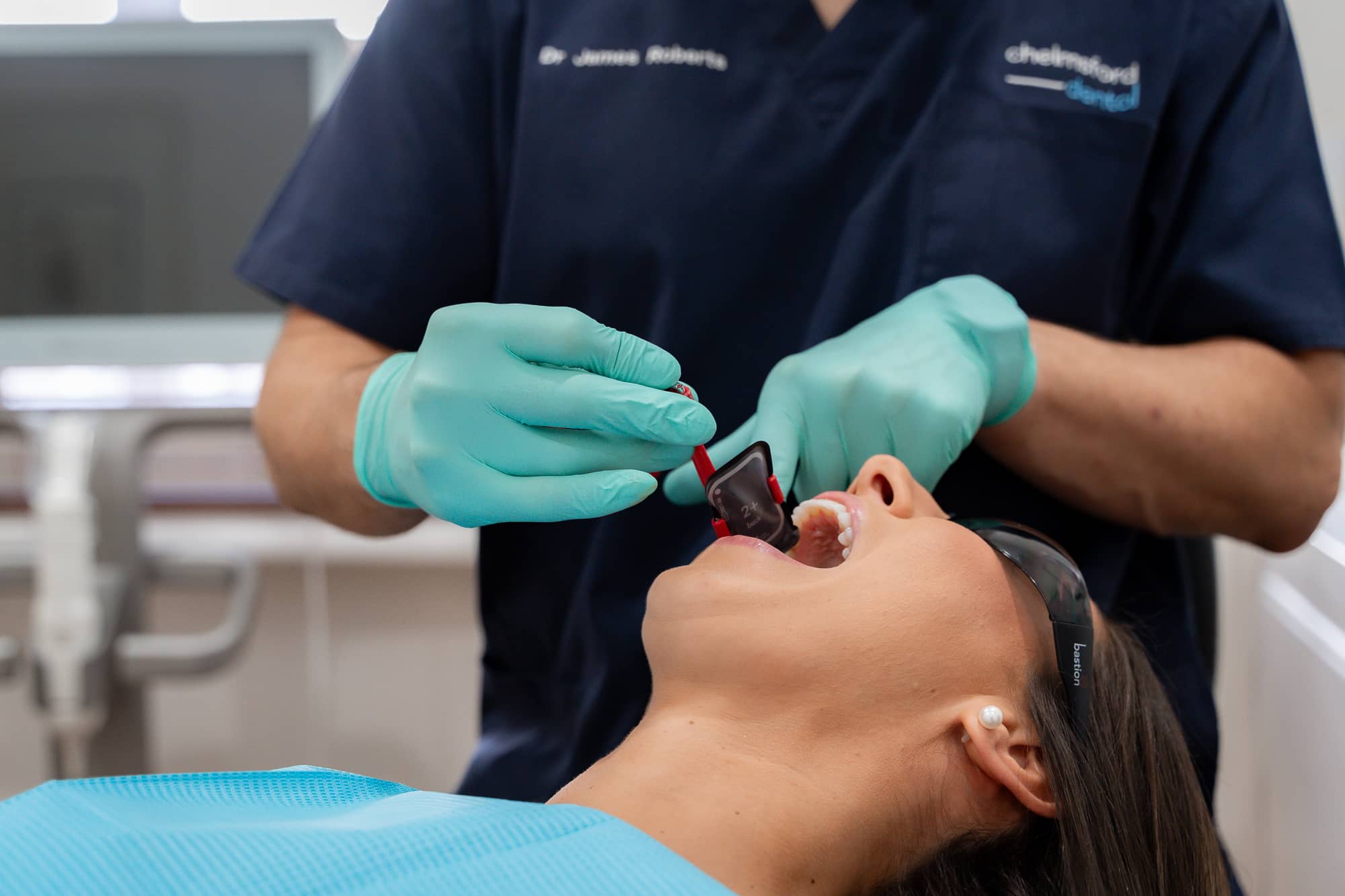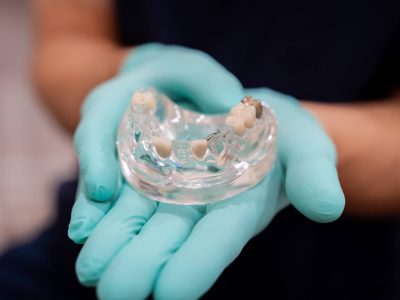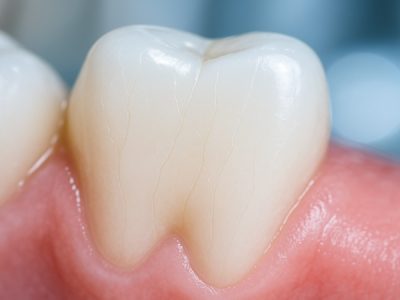Dental bridges are an effective, natural-looking solution for missing teeth. If you have one or more missing teeth and want to restore your smile, a dental bridge may be an ideal option.
In this guide, I’ll go over the different types of dental bridges so you can understand your options and make an informed decision based on your needs.
Click here to find out more information On Chelmsford Dental’s dental bridge services
Key Takeaways: What are the types of dental bridges?
-
- There are different types of dental bridges, including traditional fixed bridges, removable bridges or partial dentures, cantilever bridges, Maryland bonded bridges, and implant-supported bridges
- Dental bridges are dental prosthetics that can be used to restore a smile if one or more teeth are missing
- Each type of dental bridge offers its own benefits and ideal use

Which Type of Dental Bridge Do I Need?
What Are Dental Bridges?
A dental bridge is a prosthetic device that can be used to replace a missing tooth or several teeth. Dental bridges offer a natural-looking, effective solution that feels and functions like natural teeth.
You can think of a dental bridge as a way to “Bridge the Gap” if a tooth is missing.
A dental bridge generally consists of one or more artificial teeth (pontics) secured to dental crowns on adjacent teeth.
Dental bridges offer several benefits, such as preventing adjacent teeth from shifting, preventing jaw bone loss after losing a tooth, restoring speech and chewing function, and offering a self-confidence boost.
Why Do You Need Dental Bridges?
Dental bridges may be an ideal option for you if:
- You have healthy teeth on both sides of the gap left by the missing tooth or teeth
- You want to restore your smile in a way that looks and feels natural
- You have recently lost one or more teeth
- You want to replace a missing tooth but still speak clearly
- You want a tooth replacement option that still lets you eat your favourite foods
- You need to replace a dental bridge
- You do not have enough bone to get a dental implant
- You prefer a non-surgical option to replace a missing tooth
- You are not a good candidate for dental implant surgery
- You want to help prevent jaw bone loss and maintain your face shape after losing a tooth or teeth
Learn More: What You Need to Know About Dental Bridges
What Are the Types of Dental Bridges?
Here are the main types of dental bridges:
- Traditional fixed bridges
- Removable bridge or partial denture
- Cantilever bridges
- Maryland bonded bridges
- Implant-supported bridge
-
Traditional Fixed Bridges
Traditional fixed bridges are one of the most common bridge types. This method is ideal if you have two healthy teeth that are on each side of the gap left by a missing tooth.
These healthy adjacent teeth — also known as abutment teeth — are reshaped to be fitted with crowns. The crowns provide an anchoring point for the dental bridge to be cemented to.
Construction:
- Usually made of porcelain or metal but can also be made of porcelain fused to metal
- Cemented to abutment teeth that have been fitted with crowns
Benefits:
- Strong and durable restoration
- Mimic the appearance of natural teeth
- Restores bite force
- Prevents remaining teeth from shifting
Ideal for:
- Replacing missing molars
- Replacing a missing tooth or teeth when there are healthy natural teeth on each side of the gap
-
Removable Bridges or Partial Dentures
Most dental bridges are fixed in place, but a removable dental bridge can be a better option for certain individuals.
Removable dental bridges, also known as partial dentures, are not as secure or durable as traditional dental bridges, so I only recommend these in certain cases.
Construction:
- Made from a plastic base designed to match your gums
- Metal clasps secure it to adjacent teeth
Benefits:
- Less expensive than dental implants or crowns
- Offers the convenience of being able to remove the dental bridge if necessary
Ideal for:
- Certain scenarios where the individual will benefit from the ability to remove the bridge
-
Cantilever Bridges
A cantilever dental bridge relies on a single anchor tooth to hold the artificial tooth in place. This makes a cantilever bridge a good option for patients who only have one healthy adjacent tooth.
However, cantilever bridges cannot handle the massive bite force of the back teeth. Since the front of the mouth has lower bite force, a cantilever bridge is better suited to replacing a missing tooth at the front of the mouth.
Construction:
- Traditionally made from a combination of porcelain or metal
Benefits:
- Can be used when there is only one natural tooth adjacent to the missing tooth gap
- Help preserve the structure and placement of surrounding teeth
- Offer a natural-looking, functional missing tooth solution
Ideal for:
- When adjacent teeth are only on one side of the missing tooth or teeth
- Replacing missing teeth at the front of the mouth
-
Maryland Bonded Bridges
Maryland Bonded Bridges, also known as resin-bonded bridges, are similar to traditional dental bridges.
The difference is that Maryland-bonded bridges do not completely cover the adjacent teeth. Rather, a Maryland-bonded bridge is secured to existing teeth with a metal framework bonded to the abutment teeth.
Construction:
- Consists of metal or porcelain wings bonded to adjacent teeth
- Relies on two abutment teeth, with one on each side of the gap
- The pontic is usually constructed from porcelain or a porcelain-metal mix
Benefits:
- Does not require crowns
- Requires minimal to no reshaping of abutment teeth
Ideal for:
- Replacing a single tooth in the front of the mouth where there is minimal bite force
- Patients who want a more conservative alternative to traditional dental bridges
-
Implant Supported Bridge
An implant-supported bridge is secured to a dental implant rather than a metal framework or crowns.
An implant-supported bridge is considered the most stable but it does require surgery and can take months to be finished.
Construction:
- Uses dental implants made from titanium or zirconia as abutments
Benefits:
- Does not require adjacent natural teeth to be altered or filed down
- Distributes bite force evenly throughout the jawbone
- Provides a natural, comfortable feel
- Exceptionally durable and stable
Ideal for:
- Replacing teeth anywhere in the mouth, including the molars, as implant-supported bridges can handle an immense amount of bite force
- Can be used in cases where three or more teeth are missing in a row
How Do I Know If A Dental Bridge Is Right for Me?
Dental bridges are an effective method for replacing a missing tooth or teeth. Your dentist can determine the best type of dental bridge to restore your smile and leave you with a natural result.
If you are looking for a solution for tooth loss, our team at Chelmsford Dental can help you find the option that is best for you. Whether you are missing one tooth or several teeth, we offer dental bridges and other effective tooth replacement solutions.
Book your consultation or contact us with questions to find out if you are a good candidate for a dental bridge.





